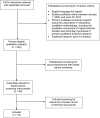Women's Experiences of Inaccurate Breast Cancer Screening Results: A Systematic Review and Qualitative Meta-synthesis
- PMID: 27468327
- PMCID: PMC4947976
Women's Experiences of Inaccurate Breast Cancer Screening Results: A Systematic Review and Qualitative Meta-synthesis
Abstract
Background: Adjunct screening with ultrasound has the potential to detect breast cancers that may not be visible on screening mammography. The use of adjunct ultrasonography is thought to be a safe and inexpensive approach to improving the sensitivity of screening with mammography alone, but potentially at the expense of increasing the rate of false-positive findings. The objective of this review was to examine women's experiences of inaccurate breast cancer screening results and how they affect perceptions of breast cancer screening technologies.
Methods: This report synthesizes 16 primary qualitative studies, which together involved 690 participating women, to examine women's experiences of inaccurate breast cancer screening results. Qualitative meta-synthesis was used to integrate findings across primary research studies.
Results: The experience of a false-positive result caused short-term anxiety until the negative result was confirmed. It also led to reoccurring anxiety during future screening. The anxiety experienced in the face of a false-positive result was magnified in high-risk women, who often reflected on the previous breast cancer experiences of family members while awaiting further results. Despite this increased anxiety, women who had experienced a false-positive result were generally not deterred from future screening. Rather, the experiences heightened their awareness of breast cancer and led to a desire for more examinations and more technologies. Women who had experienced false-negative results struggled to restore trust in screening but recognized that some breast cancers were identified through mammography. They were willing to see themselves as exceptions to an otherwise beneficial service.
Conclusions: Qualitative studies provide some insight into how breast cancer screening inaccuracy affects women, including their faith in the screening technology. Although women suffered marked anxiety from experiencing false-positive mammography tests and loss of confidence from false-negative results, these feelings generally did not diminish women's belief in the value of mammography screening. In many cases, the experiences reinforced the importance of risk reduction as well as screening.
Similar articles
-
Mammography in combination with breast ultrasonography versus mammography for breast cancer screening in women at average risk.Cochrane Database Syst Rev. 2023 Mar 31;3(3):CD009632. doi: 10.1002/14651858.CD009632.pub3. Cochrane Database Syst Rev. 2023. PMID: 36999589 Free PMC article.
-
How lived experiences of illness trajectories, burdens of treatment, and social inequalities shape service user and caregiver participation in health and social care: a theory-informed qualitative evidence synthesis.Health Soc Care Deliv Res. 2025 Jun;13(24):1-120. doi: 10.3310/HGTQ8159. Health Soc Care Deliv Res. 2025. PMID: 40548558
-
Health professionals' experience of teamwork education in acute hospital settings: a systematic review of qualitative literature.JBI Database System Rev Implement Rep. 2016 Apr;14(4):96-137. doi: 10.11124/JBISRIR-2016-1843. JBI Database System Rev Implement Rep. 2016. PMID: 27532314
-
Signs and symptoms to determine if a patient presenting in primary care or hospital outpatient settings has COVID-19.Cochrane Database Syst Rev. 2022 May 20;5(5):CD013665. doi: 10.1002/14651858.CD013665.pub3. Cochrane Database Syst Rev. 2022. PMID: 35593186 Free PMC article.
-
Home treatment for mental health problems: a systematic review.Health Technol Assess. 2001;5(15):1-139. doi: 10.3310/hta5150. Health Technol Assess. 2001. PMID: 11532236
Cited by
-
Supplemental Screening as an Adjunct to Mammography for Breast Cancer Screening in People With Dense Breasts: A Health Technology Assessment.Ont Health Technol Assess Ser. 2023 Dec 19;23(9):1-293. eCollection 2023. Ont Health Technol Assess Ser. 2023. PMID: 39364436 Free PMC article.
-
Systematic review on women's values and preferences concerning breast cancer screening and diagnostic services.Psychooncology. 2019 May;28(5):939-947. doi: 10.1002/pon.5041. Epub 2019 Mar 24. Psychooncology. 2019. PMID: 30812068 Free PMC article.
-
Subsequent attendance in a breast cancer screening program after a false-positive result in the Local Health Authority of Bologna (Italy).Sci Rep. 2021 Apr 20;11(1):8530. doi: 10.1038/s41598-021-87864-x. Sci Rep. 2021. PMID: 33879804 Free PMC article.
-
Screening participation after a false positive result in organized cervical cancer screening: a nationwide register-based cohort study.Sci Rep. 2020 Sep 22;10(1):15427. doi: 10.1038/s41598-020-72279-x. Sci Rep. 2020. PMID: 32963299 Free PMC article.
-
Benefits and Risks of Mammography Screening in Women Ages 40 to 49 Years.J Prim Care Community Health. 2022 Jan-Dec;13:21501327211058322. doi: 10.1177/21501327211058322. J Prim Care Community Health. 2022. PMID: 35068237 Free PMC article.
References
-
- Wilczynski NL, Marks S, Haynes RB. Search strategies for identifying qualitative studies in CINAHL. Qual Health Res. 2007;17 (5): 705–10. - PubMed
-
- Wong S, Wilczynski NL, Haynes RB. Developing optimal search strategies for detecting clinically relevant qualitative studies in MEDLINE. Medinfo. 2004;11 (Pt 1): 311–6. - PubMed
-
- Sandelowski M, Barroso J. Creating metasummaries of qualitative findings. Nurs Res. 2003;52 (4): 226–33. - PubMed
Publication types
MeSH terms
LinkOut - more resources
Full Text Sources
Medical

